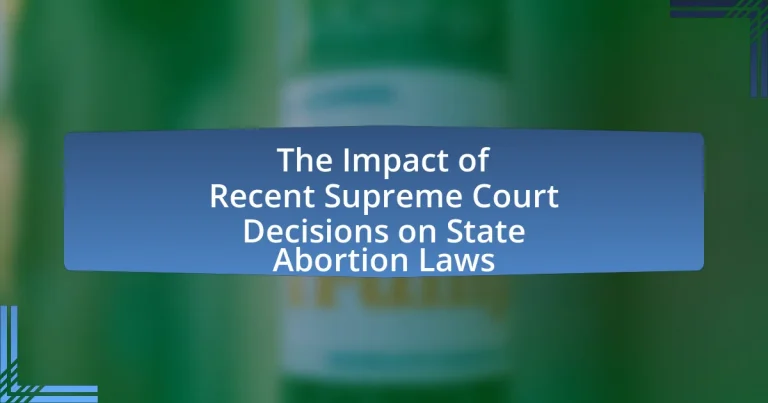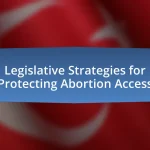The article examines the significant impact of recent Supreme Court decisions, particularly the ruling in Dobbs v. Jackson Women’s Health Organization, on state abortion laws in the United States. It outlines how the overturning of Roe v. Wade has led to a diverse array of state-level regulations, resulting in increased restrictions in some states while others have enacted protections for abortion access. The article further explores the implications of these legal changes on public opinion, legislative actions, and access to abortion services, highlighting the emerging trends and challenges faced by individuals seeking reproductive healthcare across different states. Additionally, it discusses the role of advocacy groups and potential future legal developments that may continue to shape the landscape of abortion rights.
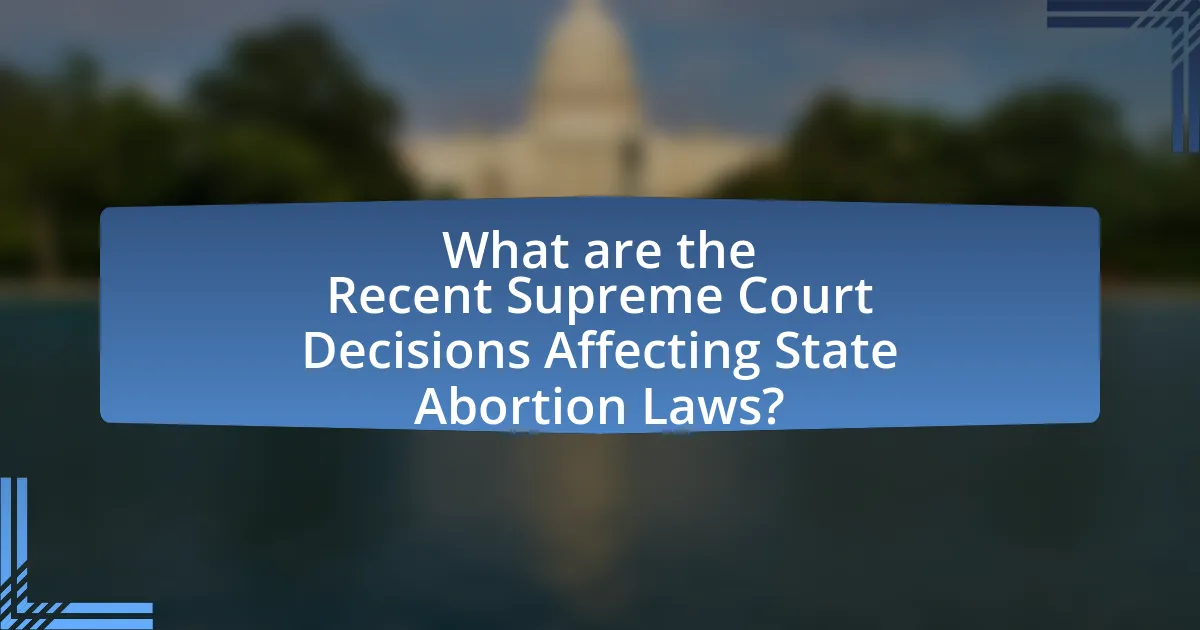
What are the Recent Supreme Court Decisions Affecting State Abortion Laws?
The recent Supreme Court decision affecting state abortion laws is the ruling in Dobbs v. Jackson Women’s Health Organization, issued on June 24, 2022. This landmark decision overturned Roe v. Wade, effectively removing the federal constitutional right to abortion and allowing individual states to regulate or ban abortion as they see fit. Following this ruling, numerous states enacted laws that either severely restrict or completely ban abortion, reflecting a significant shift in the legal landscape surrounding reproductive rights in the United States.
How have these decisions changed the legal landscape for abortion in the United States?
Recent Supreme Court decisions have significantly altered the legal landscape for abortion in the United States by overturning Roe v. Wade, which previously established a constitutional right to abortion. This shift has empowered individual states to enact their own abortion laws, leading to a patchwork of regulations across the country. For instance, following the decision in Dobbs v. Jackson Women’s Health Organization in June 2022, numerous states implemented restrictive laws or outright bans on abortion, while others have moved to protect access. This has resulted in increased disparities in abortion access, with some states enacting laws that severely limit or eliminate the procedure, while others maintain or expand protections for reproductive rights.
What specific cases have been pivotal in altering state abortion laws?
The specific cases pivotal in altering state abortion laws include Roe v. Wade (1973) and Dobbs v. Jackson Women’s Health Organization (2022). Roe v. Wade established a constitutional right to abortion, which significantly influenced state laws by prohibiting states from banning the procedure before fetal viability. Conversely, Dobbs v. Jackson Women’s Health Organization overturned Roe, allowing states to implement stricter abortion regulations and bans, leading to a wave of new state laws restricting access to abortion across the United States. These cases have fundamentally reshaped the legal landscape regarding abortion rights at the state level.
How do these decisions reflect the current political climate regarding abortion?
Recent Supreme Court decisions, particularly the overturning of Roe v. Wade, reflect a significant shift in the political climate regarding abortion, indicating a move towards more restrictive state laws. This shift has empowered states to enact laws that limit access to abortion services, aligning with the priorities of conservative political agendas that advocate for pro-life policies. For instance, following the Supreme Court’s decision, numerous states quickly implemented stringent abortion bans, showcasing the immediate influence of judicial rulings on legislative actions. This trend illustrates a polarized political landscape where abortion rights are increasingly contested, with public opinion and political affiliations heavily influencing state-level legislation.
What implications do these decisions have for state legislatures?
Recent Supreme Court decisions significantly empower state legislatures to enact and enforce stricter abortion laws. These rulings have shifted the legal landscape, allowing states greater autonomy in regulating abortion, which can lead to a patchwork of laws across the country. For instance, following the overturning of Roe v. Wade, many states quickly moved to implement bans or severe restrictions, reflecting the political and social climates within those states. This trend indicates that state legislatures must now navigate complex legal and ethical considerations while responding to constituents’ views on abortion, potentially leading to increased polarization and legislative activity surrounding reproductive rights.
How are states responding to the Supreme Court’s rulings on abortion?
States are responding to the Supreme Court’s rulings on abortion by enacting a range of laws that either restrict or protect access to abortion services. Following the Supreme Court’s decision in Dobbs v. Jackson Women’s Health Organization, which overturned Roe v. Wade, many states with pre-existing trigger laws quickly implemented bans on abortion, while others have moved to strengthen protections for abortion rights. For instance, states like Texas and Alabama have enacted strict abortion bans, whereas states such as California and New York have passed legislation to safeguard and expand access to abortion services. This divergence illustrates a significant shift in state-level abortion policies in direct response to the Supreme Court’s rulings.
What trends are emerging in state-level abortion legislation post-decision?
Emerging trends in state-level abortion legislation post-decision include an increase in restrictive laws in conservative states and efforts to protect access in liberal states. Following the Supreme Court’s decision to overturn Roe v. Wade, states like Texas and Florida have enacted stricter abortion bans, often with limited exceptions, reflecting a significant shift towards more conservative policies. Conversely, states such as California and New York are implementing measures to safeguard and expand abortion access, including codifying the right to abortion and increasing funding for reproductive health services. This dual trend highlights a growing polarization in abortion legislation across the United States, with states taking divergent paths based on their political leanings.
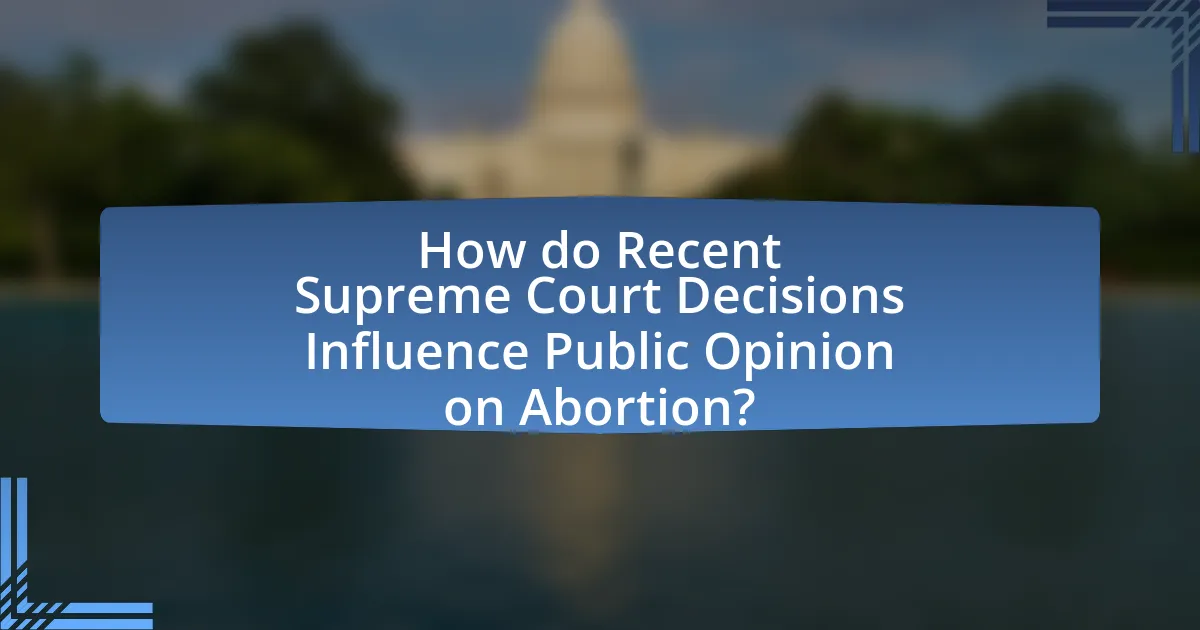
How do Recent Supreme Court Decisions Influence Public Opinion on Abortion?
Recent Supreme Court decisions significantly influence public opinion on abortion by shaping the legal landscape and prompting public discourse. For instance, the 2022 decision in Dobbs v. Jackson Women’s Health Organization overturned Roe v. Wade, leading to a surge in public engagement and polarized opinions on abortion rights. Polls conducted after the ruling indicated that a majority of Americans opposed the decision, reflecting a shift in public sentiment towards supporting abortion access. This decision has also catalyzed grassroots movements and increased political mobilization around reproductive rights, demonstrating how judicial rulings can directly affect societal views and activism regarding abortion.
What role does public sentiment play in shaping state abortion laws?
Public sentiment significantly influences state abortion laws by reflecting the values and beliefs of the electorate, which lawmakers consider when drafting legislation. For instance, states with a majority of constituents supporting abortion rights tend to enact more permissive laws, while those with a majority opposing abortion often implement stricter regulations. A 2021 Gallup poll indicated that 58% of Americans identified as pro-choice, which correlates with states like California and New York adopting more liberal abortion policies. Conversely, states such as Texas and Alabama, where public sentiment leans towards restricting abortion, have passed stringent laws following the Supreme Court’s decisions that allow for greater state control over abortion regulations.
How have recent rulings affected public attitudes towards abortion rights?
Recent rulings, particularly the Supreme Court’s decision to overturn Roe v. Wade in 2022, have significantly shifted public attitudes towards abortion rights, leading to increased polarization. Polls indicate that support for abortion rights has risen, with a Gallup poll showing that 55% of Americans identified as pro-choice in 2023, up from 48% in 2021. This change reflects a backlash against perceived restrictions on reproductive rights, as many individuals view the rulings as a threat to personal autonomy and healthcare access. Additionally, state-level legislative actions following these rulings have prompted widespread activism and mobilization, further influencing public sentiment and engagement on the issue.
What surveys or studies illustrate changes in public opinion following these decisions?
Surveys and studies that illustrate changes in public opinion following recent Supreme Court decisions on state abortion laws include the Pew Research Center’s 2022 survey, which found that 61% of Americans believe abortion should be legal in all or most cases, a notable increase from previous years. Additionally, a Gallup poll conducted in 2022 indicated that 55% of respondents identified as pro-choice, reflecting a shift in attitudes post-decision. These findings demonstrate a significant change in public sentiment regarding abortion rights in the wake of judicial rulings.
How do these decisions impact access to abortion services across different states?
Recent Supreme Court decisions significantly impact access to abortion services across different states by allowing individual states to impose their own regulations and restrictions. For instance, following the overturning of Roe v. Wade in 2022, many states enacted laws that either severely limit or completely ban abortion, leading to disparities in access. According to the Guttmacher Institute, as of 2023, 13 states have enacted total bans on abortion, while others have implemented gestational limits or mandatory waiting periods, creating a patchwork of access that varies widely. This legal landscape results in some states having robust access to abortion services, while others effectively eliminate them, disproportionately affecting low-income individuals and those in rural areas who may lack the means to travel to states with fewer restrictions.
What barriers to access are being created or removed by state laws?
State laws are creating barriers to access by implementing stricter regulations on abortion services, such as mandatory waiting periods, parental consent requirements for minors, and limitations on when abortions can be performed. For example, several states have enacted laws that require individuals to undergo counseling and wait 24 to 72 hours before obtaining an abortion, which can delay access and increase costs. Conversely, some states are removing barriers by enacting laws that protect abortion rights, ensuring access to services without excessive restrictions. For instance, states like California and New York have passed legislation to safeguard abortion access in response to federal changes, thereby enhancing availability and reducing obstacles for individuals seeking these services.
How do socioeconomic factors influence access to abortion in various states?
Socioeconomic factors significantly influence access to abortion across various states by affecting individuals’ financial ability to seek services, availability of healthcare facilities, and state policies. For instance, states with higher poverty rates often have fewer clinics and resources, making it more difficult for low-income individuals to obtain abortions. According to the Guttmacher Institute, states with restrictive abortion laws tend to have higher rates of poverty and lower levels of education, which correlate with reduced access to reproductive healthcare. Additionally, transportation barriers in rural areas further exacerbate the challenges faced by those in lower socioeconomic brackets, limiting their ability to reach abortion providers.
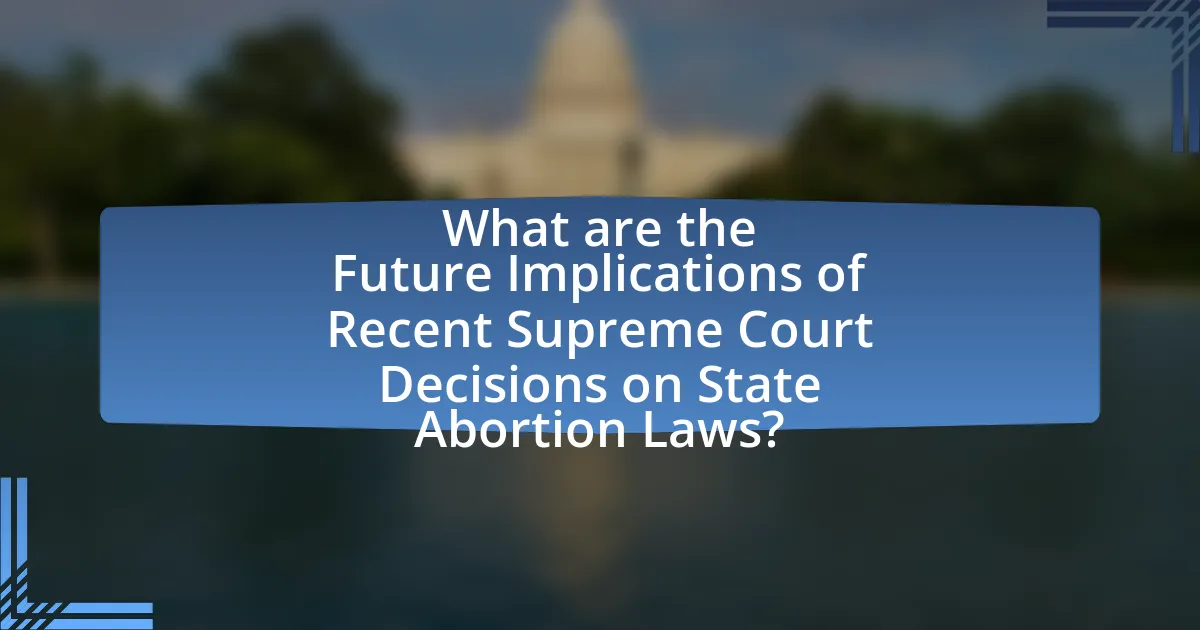
What are the Future Implications of Recent Supreme Court Decisions on State Abortion Laws?
Recent Supreme Court decisions, particularly the overturning of Roe v. Wade, have significant implications for state abortion laws, leading to increased variability in access to abortion services across the United States. States now have the authority to enact restrictive laws, resulting in a patchwork of regulations where some states may impose severe limitations or outright bans, while others may protect access to abortion. This shift has already led to a surge in legislative activity, with at least 13 states implementing total bans and many others enacting gestational limits or mandatory waiting periods. The implications also extend to potential legal challenges, as states may face lawsuits over their laws, which could further shape the national landscape of reproductive rights.
How might future Supreme Court cases further affect state abortion laws?
Future Supreme Court cases may significantly reshape state abortion laws by establishing new legal precedents or clarifying existing ones. For instance, if the Court were to hear cases challenging state-level restrictions or protections, it could either uphold or strike down these laws based on interpretations of constitutional rights, such as privacy or equal protection. Historical context shows that the Supreme Court’s decisions, like Roe v. Wade in 1973 and Dobbs v. Jackson Women’s Health Organization in 2022, have directly influenced state legislation by either expanding or limiting access to abortion services. Thus, the outcomes of future cases could lead to a patchwork of state laws that vary widely, depending on the Court’s rulings and the political landscape in individual states.
What legal precedents could be challenged in upcoming cases?
Legal precedents that could be challenged in upcoming cases include Roe v. Wade and Planned Parenthood v. Casey, which established the constitutional right to abortion. The recent Supreme Court decision in Dobbs v. Jackson Women’s Health Organization has already overturned Roe v. Wade, creating a legal landscape where states can impose stricter abortion laws. This shift opens the door for challenges to existing precedents that protect abortion rights, as states may seek to implement laws that directly contradict the principles established in these earlier cases. The implications of these challenges could redefine the legal framework surrounding reproductive rights in the United States.
How are advocacy groups preparing for potential changes in the legal landscape?
Advocacy groups are preparing for potential changes in the legal landscape by developing strategic legal frameworks and mobilizing grassroots campaigns. These organizations are closely monitoring legislative developments and court rulings to adapt their strategies accordingly. For instance, following the Supreme Court’s decision in Dobbs v. Jackson Women’s Health Organization, which overturned Roe v. Wade, groups like Planned Parenthood and the ACLU have intensified efforts to protect reproductive rights at the state level, including filing lawsuits and advocating for state legislation that safeguards access to abortion services. Additionally, they are enhancing public awareness campaigns to inform communities about their rights and available resources, ensuring that individuals are equipped to respond to legal changes effectively.
What best practices can states adopt in response to these Supreme Court decisions?
States can adopt best practices such as enacting protective legislation to safeguard access to abortion services in response to recent Supreme Court decisions. By implementing laws that explicitly protect the right to choose and ensure access to reproductive health care, states can counteract restrictive measures that may arise from these decisions. For instance, states like California and New York have enacted laws that expand access to abortion services, including funding for clinics and protections for providers. These measures demonstrate a proactive approach to maintaining reproductive rights and ensuring that individuals have access to necessary health care services, even in the face of changing federal rulings.
How can states ensure equitable access to abortion services moving forward?
States can ensure equitable access to abortion services moving forward by implementing policies that remove financial and logistical barriers to care. For instance, states can expand Medicaid coverage for abortion services, as research shows that low-income individuals are disproportionately affected by restrictions. According to the Guttmacher Institute, states that provide Medicaid funding for abortion see higher rates of access among low-income populations. Additionally, states can increase the number of clinics and healthcare providers offering abortion services, particularly in rural areas where access is limited. Data from the American College of Obstetricians and Gynecologists indicates that geographic disparities significantly impact access, with many women in rural areas facing long travel distances to obtain care. By prioritizing these strategies, states can work towards more equitable access to abortion services.
What collaborative efforts can be made to address the challenges posed by these decisions?
Collaborative efforts to address the challenges posed by recent Supreme Court decisions on state abortion laws include forming coalitions among advocacy groups, legal organizations, and healthcare providers. These coalitions can work together to share resources, develop comprehensive legal strategies, and mobilize public support. For instance, organizations like the American Civil Liberties Union and Planned Parenthood have historically collaborated to challenge restrictive laws through litigation and public campaigns, demonstrating the effectiveness of unified efforts in safeguarding reproductive rights. Additionally, partnerships with local governments can facilitate the implementation of supportive policies and access to reproductive healthcare services, thereby mitigating the impact of adverse legal decisions.
